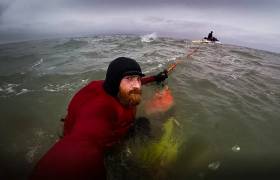Displaying items by tag: fitness
Big wave surfer Al Mennie talks to the Belfast Telegraph about how he keeps fit and healthy between his challenging surfing experiences.
In a candid Q&A, the Portrush surfer — who features in BBC Two NI show Tide this Sunday 16 June at 9.45pm — reveals the extent of the punishment he’s put his body through to ride the biggest swells.
“[From] surfing I have had broken ribs, have split my head open several times and have been concussed. I often think I’ve been very lucky.”
The “extreme” of this sportsman’s chosen field even extends to his diet — or rather, two diets.
“I eat very well and see myself as an athlete and need to fuel my body, but you will see me in a well-known fast food chain the odd time,” he says.
Perhaps understandably for someone who undertakes such a high-stakes endeavour, Mennie confesses he is “full on all the time”.
“Because I am a surfer, people think I must be chilled out — I am actually really far from being chilled out. At night I'm writing books or working on some sort of plan.”
Mennie’s book Overcome or Succumb was published last year, as previously reported on Afloat.ie. And the Belfast Telegraph has more on his story HERE.
In other surfing news, Dublin Gaelic football forward Ciaran Kilkenny tells the Irish Examiner how riding the waves had become a part of his fitness regimen.
“I generally try to go the day after a game, because you get a bit of a recovery in, too,” he says.
“Even for the head, it’s great to go to a place like Bundoran, or Strandhill or Lahinch, the sea breeze, it’s great to go down and get in the water and up on the board.”
The Irish Examiner has more on the story HERE.
Get In New Year Shape With ‘RowFit’ Classes At The Royal St George
#RowFit - The Royal St George Yacht Club has teamed up with former Olympic rower and world record holder Niall O’Toole to offer members and friends a unique fitness experience for the New Year.
Participants in the Crew Class Indoors programme will get ‘RowFit’ as they work 85% of their muscles with every stroke of the rowing machine.
The programme is described as “a fantastic unparalleled exercise to get stronger, leaner, and work your core and learn to row in a fun team environment.”
Classes began this week, with two sessions on Tuesday and Thursday evenings. For more details and how to book a session see the RStGYC website HERE.
Sports Stars Share Fitness Tips
The NDC interest is fuelled by the growing body of scientific research showing that milk can play a very positive role in sports nutrition. Specific areas of focus include hydration and muscle recovery, and the beneficial role of milk in these areas has been attributed to the natural nutritional composition of milk.
Tuesday 20th September
Champion athlete Derval O'Rourke will meet members of the public at the NDC stand from 11.00am – 3.00pm.
Twice during the day, at 11.30am and 1.45pm, there is the chance to hear Derval in a live discussion on the NDC stand with Dr. Catherine Logan, Nutrition Manager at the NDC, about Derval's preparations for the 2012 Olympic Games and top tips. The discussions will finish with a few fun basketball hoops in aid of Focus Ireland.
Wednesday 21st September
Hurling greats Michael Fennelly (Kilkenny's All-Ireland winning team) & Pádraic Maher (Tipperary & All-Ireland Finalist) will meet members of the public at the NDC stand from 11.00am-3.00pm.
Twice during the day, at 11.30am and 1.45pm, there is the chance to hear Michael Fennelly & Pádraic Maher in a live discussion on the NDC stand with Dr. Catherine Logan, Nutrition Manager at the NDC, about their top training and diet tips. The discussions will finish with a few fun basketball hoops in aid of Focus Ireland.
Thursday 22nd September
11.00am-3.00pm is your chance to meet Kieran Donaghy Kerry Gaelic footballer & 2011 All- Ireland finalist at the NDC stand. At 6'5" tall, the multi medal winner is also known for his basketball skills & played with Tralee Tigers.
Kieran Donaghy will have a live discussion with Dr. Catherine Logan at NDC, about his top training tips and tips on sports nutrition at 11.30am; finishing with fun basketball hoops for Focus Ireland.
All Three Days
Throughout the Ploughing festival, a selection of basketball giants will be at the NDC stand every day to help visitors try their shot at Hoops and talk about their experiences, with daily spot prizes.
The NDC interactive 'Photo Booth' returns by popular demand, where you can enter a free competition for the best "Cheesy Smile" which a chance to win a Digital camera each day of the Ploughing. The NDC Butter Queen will give you a taste of the delicious flavour of cooking with Irish butter, with her short-bread biscuits.
































































